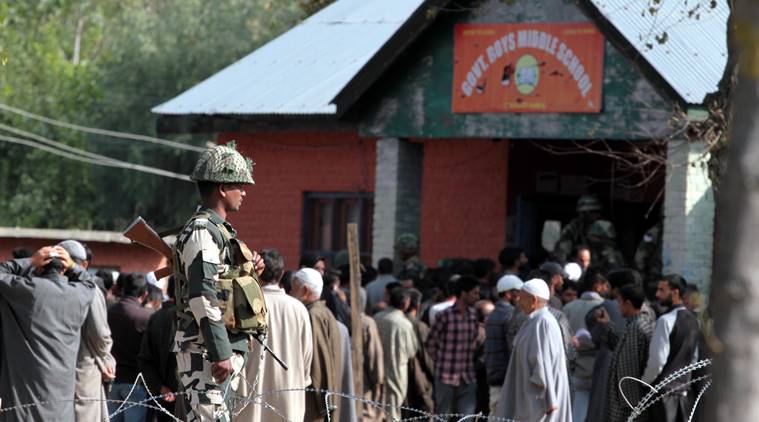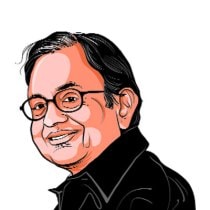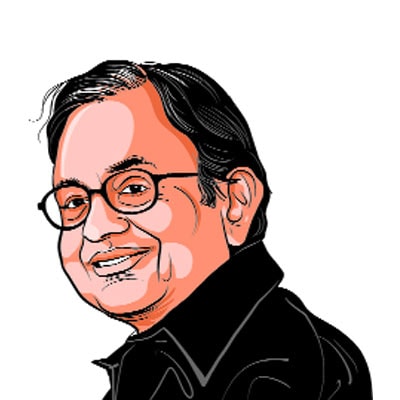Across the aisle: In J&K, the road to disaster
J&K is polarised as never before. Jammu is at odds with the Kashmir Valley, Leh leans towards Jammu and Kargil leans towards the Valley, but both Leh and Kargil also assert their identities.

A thick security blanket has been thrown around the polling stations. (File)
We have a new governor of Jammu and Kashmir, a new chief secretary, a new director general of police and a new adviser on security. The best outreach to the people of J&K (especially the Kashmir Valley) that they could come up with was to hold elections to the local bodies (panchayats and municipalities) in the state. The outreach was met with a rude rebuff when, in the first and second phases of the elections, the turnout in the Kashmir Valley was 8.2 per cent and 3.3 per cent respectively. There was no candidate or there was no vote cast in many wards; in many wards, the sole candidate was ‘elected’ unopposed!
The country had been forewarned. The Hurriyat had called upon the people to boycott the elections; the former DGP had warned (before he was abruptly removed) that the time was not opportune to hold the elections; and two of the four major parties in the state, the National Conference and the People’s Democratic Party (PDP), had decided to stay away. The third major party, the Congress, agonised over the decision but, eventually, decided to honour the wishes of the rank and file of the party. However, the Congress made it clear that if the security situation did not improve it would review the decision. Yet the government went ahead with the elections.
The elections were held under conditions that were unheard of: no list of candidates! In the Kashmir Valley,
the candidates were ‘secured’ by huddling them into hotels. No campaign, no publicity, no nothing, and yet it was called an election! It was a farce.
the candidates were ‘secured’ by huddling them into hotels. No campaign, no publicity, no nothing, and yet it was called an election! It was a farce.
Polarisation is Complete
J&K is polarised as never before. Jammu is at odds with the Kashmir Valley, Leh leans towards Jammu and Kargil leans towards the Valley, but both Leh and Kargil also assert their identities. The situation was always complex; it has been confounded by the selfish agenda pursued by the BJP. The PDP was a collaborator until the unnatural coalition government collapsed on June 19, 2018.
Jammu and Kashmir has, for many years, cried out for a political solution. Atal Bihari Vajpayee understood the need for a political solution and how it would necessarily require talking to all stakeholders, including the Hurriyat and Pakistan. He pulled out of his rich vocabulary the word insaaniyat (humanity); he rode a bus to Lahore; he invited President Musharraf to talks at Agra, but ultimately he failed because he could not prevail over the hawks in his party and in the RSS and he could not contain the security forces operating in the state.
Mr Narendra Modi’s tenure has seen such wild swings in approach that one is hard put to determine if there is a policy at all. ‘Blow hot, blow cold’ would be a charitable description of the numerous flip-flops. The BJP, as a political party, always believed — and more so under
Mr Modi — in a muscular, militaristic and maximalist policy to suppress dissent and enforce law and order. It has stoked hyper-nationalism to consolidate its position in the Jammu region. It also believes it has found another ghost to slay — the ‘misguided’ youth of Kashmir — and, thereby, rally the hyper-nationalist elements in the rest of the country.
Why are People Dying?
The country has paid and is paying a heavy price for the flawed policy of the BJP-led NDA. The Table will speak for
itself: Nor has Pakistan been tamed. The muscular approach has not stopped infiltration: the number of attempts by militants to infiltrate across the border has increased every year, from 121 (2015) to 371 (2016) to 406 (2017). The massing of security forces in the state could not prevent attacks at Nagrota (2016); Kulgam, Anantnag and Pulwama (2017); and Shopian (2018). The worst consequence of the policy is the increase in the number of young men joining the ranks of the militants in the state: a report in The Hindu (August 27, 2018) said the number had increased from 126 (2017) to 131 (2018).
itself: Nor has Pakistan been tamed. The muscular approach has not stopped infiltration: the number of attempts by militants to infiltrate across the border has increased every year, from 121 (2015) to 371 (2016) to 406 (2017). The massing of security forces in the state could not prevent attacks at Nagrota (2016); Kulgam, Anantnag and Pulwama (2017); and Shopian (2018). The worst consequence of the policy is the increase in the number of young men joining the ranks of the militants in the state: a report in The Hindu (August 27, 2018) said the number had increased from 126 (2017) to 131 (2018).

The Gains Undone
Nor has there been the promised development in the state. In some areas, the state has regressed. The drop-out rates have increased from 6.93 to 10.3 per cent for primary students and from 5.36 to 10.2 per cent for upper primary students. The doctor to population ration has worsened from 1:1552 to 1:1880. According to CMIE, private projects valued at only Rs 65 crore have been announced for the Valley in the last three years. Credit offtake has missed the target by a wide margin in 2016-17 (Rs 16,802 crore against Rs 27,650 crore) and in 2017-18 (Rs 10,951 crore against Rs 28,841 crore).
Nor has there been any progress in winning the peace. The interlocutor appointed in October 2017 has been totally forgotten. By pandering to its base in Jammu, including support to the suspects in the rape and murder at Kathua, the BJP has further isolated the people in the Kashmir Valley. The progress achieved between 2001 and 2014 has been undone.
If the situation looks bad today, it could be worse tomorrow.
More From P Chidambaram
- Across the aisle: She wanted reasons, here are 10Was the Defence Minister telling the truth when she said that she was not aware if Dassault had chosen a private sector company as the…
- Across the Aisle: Good Aadhaar, Bad AadhaarThe NDA tried to sell the false notion that if a person could not identify himself the person would not have an identity. ..
- Five steps to NirvanaExternal events are impacting the Indian economy. The government is unwilling to alter or calibrate its positions on the projected growth rate, government expenditure, NPA…







































No hay comentarios:
Publicar un comentario